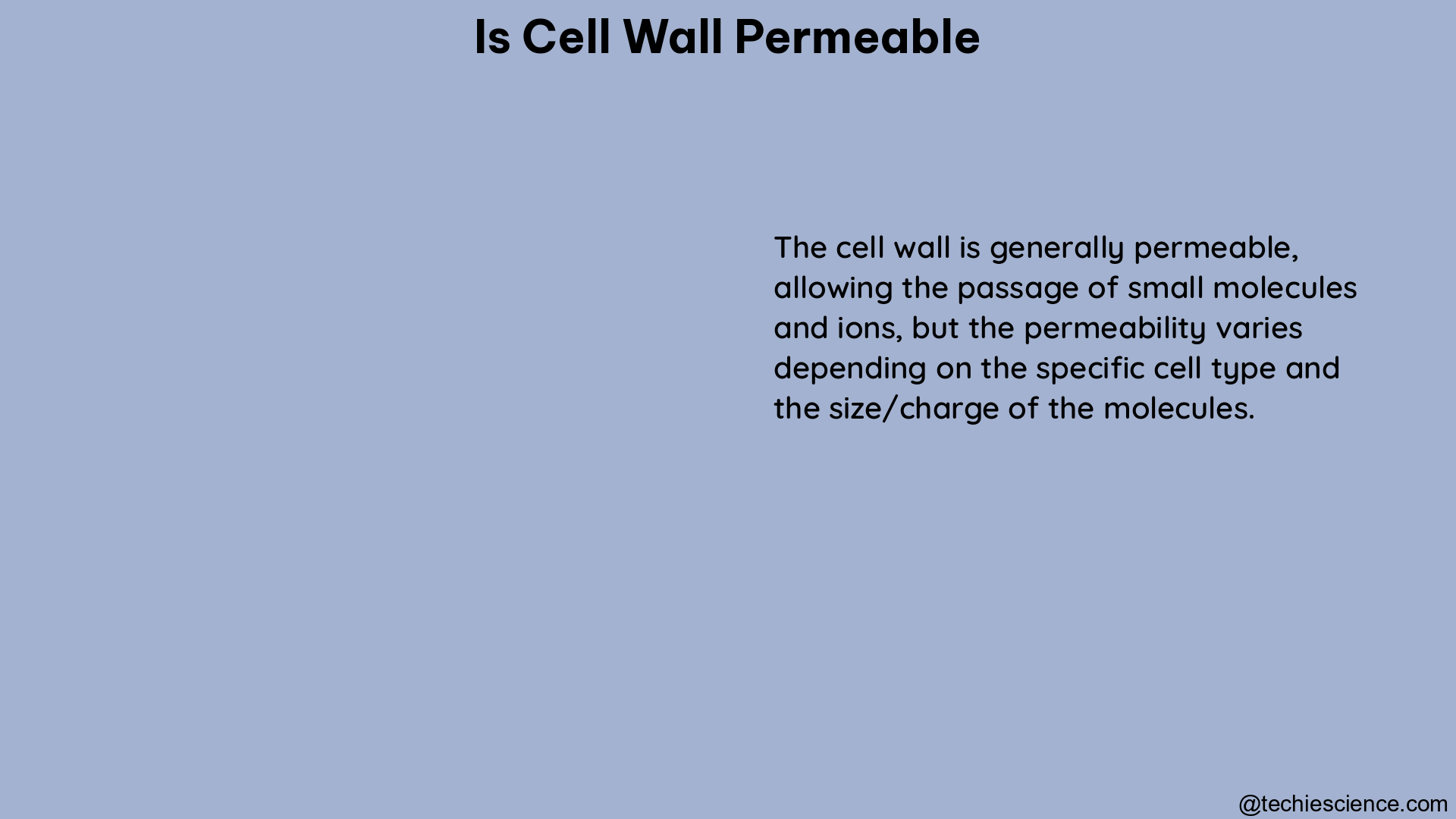The cell wall is a crucial component of plant cells, providing structural support, protection, and regulating the movement of molecules in and out of the cell. Understanding the permeability of the cell wall is essential for various applications, including plant biology, agriculture, and biotechnology. This comprehensive guide will delve into the intricacies of cell wall permeability, exploring the methods used to measure and quantify it, as well as the factors that influence this crucial property.
Measuring Cell Wall Permeability
Electroporation
Electroporation is a widely used technique for measuring and manipulating the permeability of cell walls. This method involves the application of an electric field to the cell, which can temporarily increase the permeability of the cell wall, allowing the passage of small molecules and ions. The degree of permeability can be quantified by measuring the uptake of fluorescent dyes or the release of intracellular components.
During electroporation, the electric field creates transient pores in the cell wall, allowing for the exchange of materials between the extracellular and intracellular environments. The size and duration of these pores can be controlled by adjusting the parameters of the electric field, such as the voltage, pulse duration, and number of pulses. By optimizing these parameters, researchers can achieve the desired level of cell wall permeability for their specific applications.
Time-Lapse Microscopy
Time-lapse microscopy is another powerful technique for measuring cell wall permeability. This method involves the use of fluorescent dyes or probes that can be tracked as they diffuse across the cell wall. By monitoring the rate of dye uptake or the movement of molecules through the cell wall, researchers can quantify the diffusive permeability of the cell wall.
One commonly used fluorescent dye for this purpose is propidium iodide (PI), which is a DNA-binding dye that can only enter cells with compromised cell walls. By measuring the rate of PI uptake using time-lapse microscopy, researchers can determine the permeability coefficient of the cell wall, which is a measure of how quickly a molecule can cross the barrier.
Nernst Equation
The Nernst equation is a mathematical tool used to calculate the equilibrium potential of a given ion across a cell membrane, which can provide insights into the permeability of the cell wall. The Nernst equation relates the equilibrium potential of an ion to its concentration gradient across the cell wall, as well as the charge of the ion and the temperature of the system.
By applying the Nernst equation to experimental data, researchers can determine the permeability coefficient of a specific ion, which can be used to infer the overall permeability of the cell wall. This approach is particularly useful for understanding the movement of charged molecules, such as ions, across the cell wall.
Factors Affecting Cell Wall Permeability

Temperature
Temperature is a crucial factor that can influence the permeability of the cell wall. As the temperature increases, the kinetic energy of the molecules within the cell wall increases, which can lead to a higher rate of diffusion and a corresponding increase in permeability. Conversely, lower temperatures can reduce the permeability of the cell wall by slowing down the movement of molecules.
The relationship between temperature and cell wall permeability is often described by the Arrhenius equation, which relates the rate of a chemical reaction (in this case, the rate of diffusion across the cell wall) to the temperature of the system. By measuring the permeability of the cell wall at different temperatures, researchers can determine the activation energy required for molecules to cross the barrier, providing valuable insights into the underlying mechanisms of cell wall permeability.
Solvent Type and Concentration
The type and concentration of the solvent can also significantly impact the permeability of the cell wall. Polar solvents, such as water, can interact with the charged groups and polar molecules within the cell wall, altering its structure and affecting the movement of molecules across the barrier.
Increasing the concentration of a solvent can also increase the permeability of the cell wall. This is because higher solvent concentrations can lead to changes in the osmotic pressure and the hydration state of the cell wall, which can affect the size and structure of the pores and channels within the barrier.
pH
The pH of the surrounding environment can also influence the permeability of the cell wall. Extreme pH levels can affect the charges on the membrane proteins and lipids, which can alter the structure of the cell wall and impact its permeability.
For example, in acidic environments, the protonation of certain functional groups within the cell wall can change the overall charge distribution, potentially leading to changes in the size and shape of the pores and channels. Conversely, in alkaline environments, the deprotonation of these groups can have the opposite effect, altering the permeability of the cell wall.
Presence of Molecules and Transport Proteins
The presence of certain molecules, such as hormones or signaling compounds, can also affect the permeability of the cell wall. These molecules can bind to specific receptors on the cell wall, triggering changes in the structure and function of the barrier.
Additionally, the presence of transport proteins embedded within the cell wall can facilitate the movement of specific molecules across the barrier. These transport proteins can act as selective channels, allowing the passage of certain molecules while restricting the movement of others, thereby modulating the overall permeability of the cell wall.
Practical Applications of Cell Wall Permeability
Understanding the permeability of the cell wall has numerous practical applications in various fields, including:
-
Plant Biology: Studying the permeability of the cell wall is crucial for understanding the transport of nutrients, water, and signaling molecules within plant cells, as well as the response of plants to environmental stresses.
-
Agriculture: Manipulating the permeability of the cell wall can be used to improve the uptake of agrochemicals, such as pesticides and fertilizers, by plant cells, thereby enhancing the efficiency of agricultural practices.
-
Biotechnology: Cell wall permeability is an important consideration in the development of genetically modified organisms, as it can affect the delivery of genetic material and the expression of foreign genes.
-
Drug Delivery: The permeability of the cell wall is a key factor in the development of drug delivery systems, as it can influence the ability of therapeutic compounds to cross the barrier and reach their intended targets within the cell.
-
Environmental Remediation: Understanding the permeability of the cell wall can aid in the development of bioremediation strategies, where microorganisms are used to remove or degrade environmental pollutants.
By delving into the intricacies of cell wall permeability, researchers and practitioners can unlock new possibilities in various fields, from improving agricultural productivity to enhancing the efficacy of drug delivery systems.
Conclusion
The permeability of the cell wall is a complex and multifaceted property that plays a crucial role in the functioning of plant cells. By understanding the various methods used to measure and quantify cell wall permeability, as well as the factors that influence this property, researchers and practitioners can gain valuable insights and develop innovative applications in fields ranging from plant biology to biotechnology.
References
- Weaver, J. C. (1993). Electroporation: a general phenomenon for manipulating cells and tissues. Journal of cellular biochemistry, 51(4), 426-435.
- Krasznai, Z., Márián, T., Balkay, L., Emri, M., & Trón, L. (1995). Flow cytometric determination of absolute membrane potential of cells. Journal of Photochemistry and Photobiology B: Biology, 28(2), 93-99.
- Zimmermann, U. (1986). Electrical breakdown, electropermeabilization and electrofusion. Reviews of Physiology, Biochemistry and Pharmacology, Volume 105, 175-256.
- Alberts, B., Johnson, A., Lewis, J., Raff, M., Roberts, K., & Walter, P. (2002). Molecular biology of the cell. Garland science.
- Kell, D. B., & Davey, H. M. (1996). Techniques for the measurement of changes in the permeability of biological membranes. In Membrane Transport (pp. 69-80). Springer, Boston, MA.
- Zimmermann, U., Pilwat, G., & Riemann, F. (1974). Dielectric breakdown of cell membranes. Biophysical journal, 14(11), 881-899.

Hello, I am Sugaprabha Prasath, a Postgraduate in the field of Microbiology. I am an active member of the Indian association of applied microbiology (IAAM). I have research experience in preclinical (Zebrafish), bacterial enzymology, and nanotechnology. I have published 2 research articles in an International journal and a few more are yet to be published, 2 sequences were submitted to NCBI-GENBANK. I am good at clearly explaining the concepts in biology at both basic and advanced levels. My area of specialization is biotechnology, microbiology, enzymology, molecular biology, and pharmacovigilance. Apart from academics, I love gardening and being with plants and animals.
My LinkedIn profile-